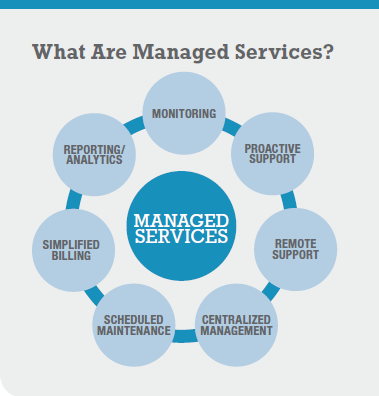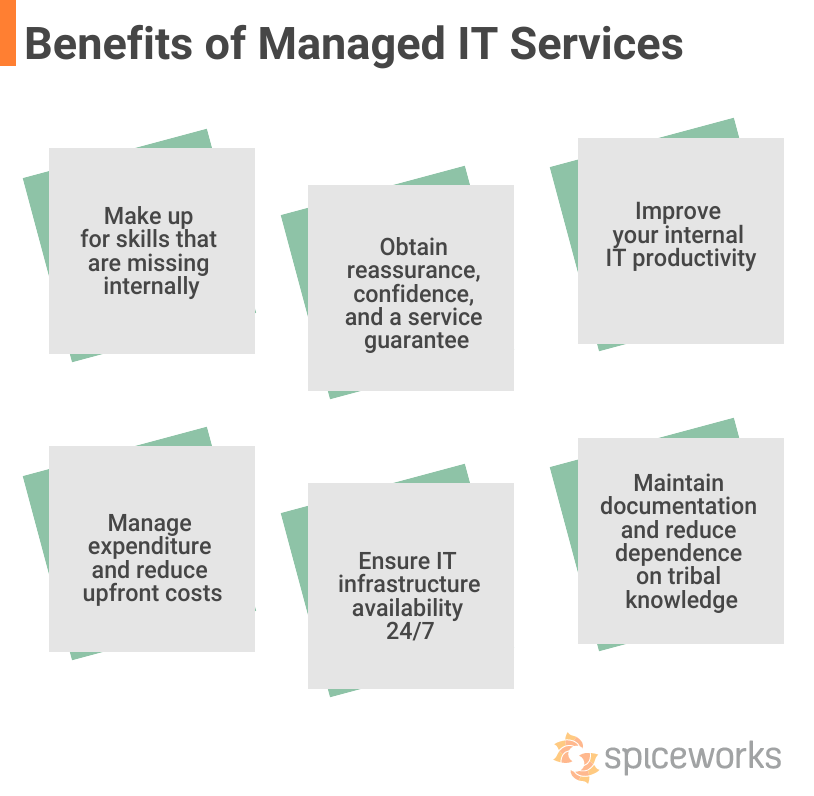10 Benefits of Managed IT Services: A Comprehensive Guide

10 Benefits of Managed IT Services: A Comprehensive Guide
One significant challenge many companies face is maintaining an efficient and secure IT infrastructure. With evolving cyber threats and the need for constant technological upgrades, this task can be overwhelming, especially for organizations without a dedicated IT department.
Managed IT services step in to address these challenges, offering a range of benefits that can transform the way businesses handle their technological needs.
Despite the economic challenges of 2023, 51% of businesses plan to increase their IT budgets in the upcoming year, with at least 60% of businesses relying on managed IT services by 2025.
| As Jason Sondhi, CEO of Sondhi Solutions, says, “Managed IT services are not just a trend; they are a strategic necessity, transforming IT challenges into opportunities for growth. |
In this blog, we’ll go through the various benefits of managed IT services and how they contribute to the overall success and resilience of a business.
By understanding the importance of managed IT services, companies can make informed decisions about their IT strategies and investments.
Gain a Reliable IT Partner!Join 43+ companies across Indiana and Ohio benefiting from Sondhi Solutions’ expertise. |
What are Managed IT Services?
Managed IT services involve outsourcing your company’s IT management and computer network technical support to a third-party provider, known as a managed service provider (MSP).
These services typically include network, application, infrastructure, and security management, with the MSP taking responsibility for the entirety of a company’s IT systems.

Source: CompTIA
Importance of Managed IT Services
The importance of managed IT services transcends the immediate operational benefits. These services are a strategic asset, integral to a company’s growth, adaptability, and long-term success in a technology-driven world.
- Strategic IT Planning: Managed IT services align technology with business goals, ensuring that IT infrastructures are not just current but also future-proof. This foresight is crucial for businesses to stay relevant and competitive.
- Risk Management and Compliance: Managed IT services ensure that businesses stay compliant. They mitigate risks associated with data breaches and non-compliance, which can have significant legal and financial implications.
- Enhancing Customer Experience: The efficiency and reliability of IT systems directly impact the customer experience. Managed IT services ensure that these systems run smoothly, thereby enhancing customer interactions and satisfaction.
- Business Focus and Growth: By taking over the complex and time-consuming tasks of IT management, managed IT services allow business owners and their teams to focus on core business strategies and growth.
Key Benefits of Managed IT Services
Managed IT services are crucial for maintaining an efficient, secure, and up-to-date IT infrastructure, which is essential for any modern business.
1. Cost Savings
One of the major benefits of managed IT services is the cost savings it offers. By outsourcing, businesses can reduce capital expenditure and convert IT costs into fixed monthly operational costs. In fact, it is estimated that successfully deploying managed services will help reduce IT costs by 25-45% and increase operational efficiency by 45-65%.
This predictable managed services model allows for better budget management. Additionally, it eliminates the financial unpredictability associated with ad-hoc IT repairs and emergency interventions.
2. Expertise and Experience
Managed service providers bring a wealth of knowledge and expertise. They stay up-to-date with the latest technologies, ensuring that your business benefits from the latest advancements without the need to train in-house teams.
This deep pool of expertise also means businesses can access specialized skills that might be too expensive or rare to maintain in-house.
Looking for Top-Notch IT Support?Experience service excellence with Sondhi Solutions’ 95.7% CSAT score. |
3. Proactive Monitoring and Management
MSPs offer continuous monitoring and proactive management of your IT systems. This approach helps in identifying and addressing issues before they escalate into serious problems, ensuring smoother day-to-day operations.
Proactive monitoring also enhances system performance and reliability, reducing the likelihood of downtime and productivity loss.
4. Enhanced Security
In today’s digital era, security is paramount. Managed IT services providers implement robust security measures to protect your data from cyber threats, thus enhancing your business’s overall security posture.
5. Scalability
As your business grows, so do your IT needs. Managed IT services offer scalability, allowing you to easily adjust your IT support and infrastructure in line with your business’s growth and changing needs.
This scalability is vital for ensuring that your IT capabilities can keep pace with your business expansion, avoiding bottlenecks and system overloads that can hinder progress.

Source: Spiceworks
6. Business Continuity and Disaster Recovery
With managed IT services, businesses benefit from robust business continuity and disaster recovery plans. This ensures minimal downtime and quick recovery in the event of a disaster.
Having a dependable plan in place is essential for maintaining operations and protecting critical data against unforeseen events, from natural disasters to cyberattacks.
7. Service Level Objectives (SLOs)
Managed IT services come with SLOs, which outline the performance and quality metrics that the service provider must meet, ensuring reliability and accountability.
These objectives provide a clear framework for service delivery, enabling businesses to set expectations and measure the effectiveness of their managed IT services.
8. Access to Advanced Technologies
Managed IT service providers often have access to the latest technologies and tools, which might be too costly or complex for businesses to implement on their own.
This access not only keeps businesses at the forefront of technological advancements but also provides them with a competitive edge in an increasingly digital marketplace.
9. Network Monitoring Across Time Zones
For businesses operating in multiple time zones, MSPs provide around-the-clock network monitoring, ensuring that your IT infrastructure always functions optimally, no matter the time or place.
This continuous monitoring is crucial for identifying and resolving issues promptly, ensuring seamless operations and enhanced productivity across different geographical locations.
10. Facilitation of Cloud Computing
Managed IT services are crucial in seamlessly integrating cloud solutions into a business’s existing IT infrastructure.
They ensure that cloud deployments are optimized for performance and security, providing businesses with the agility to adapt to changing market demands and technological advancements.
Step-by-Step Guide to Transitioning to Managed IT Services
Planning to transition to managed IT services? This guide is tailored to ensure an effective and seamless switch, helping businesses to navigate the complexities of adopting managed IT services with ease and confidence.
| Step | Description | Considerations |
| 1. Assessing Needs | Evaluate current IT infrastructure and identify areas for improvement. | Determine what IT functions are needed and what can be outsourced. |
| 2. Research Providers | Research and compile a list of potential managed IT service providers. | Look for providers with experience in your industry and strong customer reviews. |
| 3. Evaluate Expertise | Assess the technical expertise and capabilities of the providers. | Ensure they have the necessary skills and resources to meet your IT needs. |
| 4. Cost Analysis | Compare the costs of in-house management versus outsourcing to a managed IT service. | Consider long-term savings, not just immediate costs. |
| 5. Review Service Offerings | Examine the range of services each provider offers. | Check for key services like 24/7 monitoring, cybersecurity, and cloud management. |
| 6. Check Compliance | Ensure the provider meets industry-specific compliance and regulatory standards. | Verify their compliance with standards like GDPR, HIPAA, etc. |
| 7. Plan Transition | Develop a detailed plan for transitioning to the managed IT service provider. | Plan should minimize disruption to your business operations. |
| 8. Implement Training | Train staff on new procedures and how to interact with the managed IT service. | Ensure employees are comfortable with the changes and know who to contact for IT issues. |
| 9. Monitor and Review | Regularly review the performance of the managed IT service. | Set benchmarks for performance and schedule regular check-ins. |
Maximize Managed IT Benefits with Sondhi Solutions
Embracing managed IT services is a forward-thinking choice for businesses aiming to streamline their IT operations and focus on growth.
By partnering with Sondhi Solutions, your business can benefit from our extensive experience and tailored approach to IT management.
Reach out to Sondhi Solutions for a free consultation to diagnose your IT needs together.


